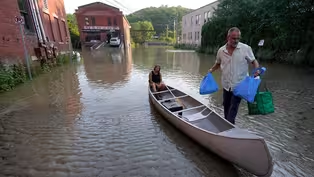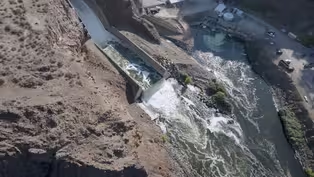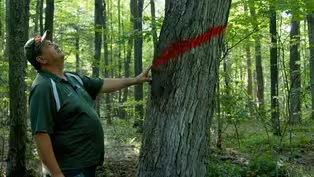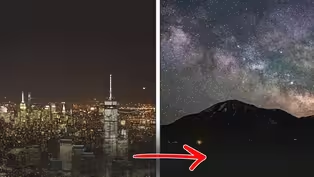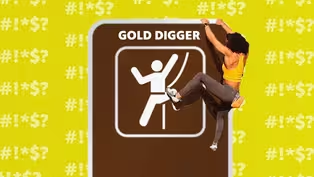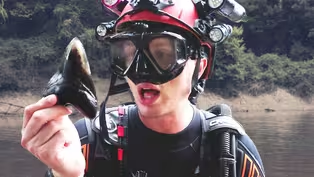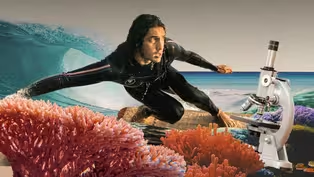
Understory | We’re Running Out of Sand
Special | 13m 7sVideo has Closed Captions
Sand may seem unremarkable, but the modern world is built on it and we’re running out.
From skyscrapers to cell phones, the modern world is built on sand, and we are running out. Baratunde Thurston learns why solving the sand crisis matters to the future of the planet—and the outdoor environments we cherish.
Problems playing video? | Closed Captioning Feedback
Problems playing video? | Closed Captioning Feedback
Major support is provided by Anne Ray Foundation, a Margaret A. Cargill Philanthropy and the Richard King Mellon Foundation. Support is also provided by John and Ruth Huss, Susan and...

Understory | We’re Running Out of Sand
Special | 13m 7sVideo has Closed Captions
From skyscrapers to cell phones, the modern world is built on sand, and we are running out. Baratunde Thurston learns why solving the sand crisis matters to the future of the planet—and the outdoor environments we cherish.
Problems playing video? | Closed Captioning Feedback
How to Watch America Outdoors with Baratunde Thurston
America Outdoors with Baratunde Thurston is available to stream on pbs.org and the free PBS App, available on iPhone, Apple TV, Android TV, Android smartphones, Amazon Fire TV, Amazon Fire Tablet, Roku, Samsung Smart TV, and Vizio.
Buy Now
Providing Support for PBS.org
Learn Moreabout PBS online sponsorshipMore from This Collection
How does our country’s diverse landscape shape our experience of the outdoors? That’s the central question behind the new PBS digital series, America Outdoors: Understory. Join host, Baratunde Thurston, as he explores the unexpected places and ways Americans encounter nature, and how their time outside is impacted by climate change, equity, access, outdoor culture and more.
Understory | Climate Change's Effects on Vermont Flooding
Video has Closed Captions
Discover the science behind this summer’s historic and devasting floods in Vermont. (13m)
Understory | How Engineered Mosquitos Could Save Birds
Video has Closed Captions
Discover how bacteria could be the key to stopping mosquito-borne illnesses. (11m 37s)
Understory | Can Dam Demolition Save California's Salmon?
Video has Closed Captions
What happens when you remove dams that changed the Klamath River a hundred years ago? (11m 54s)
Understory | Can Ancient Wisdom Save the Forests?
Video has Closed Captions
Forests are in trouble, but could ancient wisdom be the answer to saving our trees? (11m 54s)
Understory | The Movement to Save Our Night Skies
Video has Closed Captions
Explore one small town’s mission to save the night sky and help migrating birds. (12m 59s)
Understory | Rock Climbing's Troubled Route Naming Tradition
Video has Closed Captions
Baratunde meets a rock climber who is working to diversify the sport. (8m 48s)
Understory | How the Houseplant Boom Fueled Plant Poaching
Video has Closed Captions
Baratunde meets a plant parent who is bringing awareness to the issue of plant poaching. (7m 31s)
Understory | The Fossil Hunter Uncovering Florida’s Past
Video has Closed Captions
Baratunde meets a Florida fossil hunter and learns how this hobby contributes to science. (9m 11s)
Understory | Meet the Suburban Deer Hunters of Long Island
Video has Closed Captions
Baratunde meets a female suburban bowhunter to discuss how the sport is changing. (8m 35s)
Understory | The Scientist Surfing to Fight Climate Change
Video has Closed Captions
Baratunde meets a surfer scientist in Hawaii who is trying to protect the corals reefs. (10m 6s)
Providing Support for PBS.org
Learn Moreabout PBS online sponsorship- [Baratunde] When I think of sand, I think of beaches, riverbanks, maybe big old sand dunes.
But it turns out we use sand for just about everything.
- I wish people understood that sand is literally used in everything.
Toothpaste, paint, coastal restoration, your phone.
Sand is everywhere, whether you like it or not.
And we're running out of it.
- Now, if you're like me, you're thinking, sand has a crisis?
We have way too many other crises for sand to try to crowd in on the action.
What is going on here?
(bright music) To understand the importance of sand, we need to travel to the mouth of the Mississippi River, where the sand you expect along the coastline is disappearing.
- Coastal Louisiana is eroding and disappearing more rapidly than it should.
- [Baratunde] The wetlands along the Louisiana coastline are basically formed by sediment, sand, clay, and silt that the Mississippi River carries along and deposits when it reaches the open ocean.
And for thousands of years, the river was pretty good at moving this sediment, growing the delta a few square miles per year, until it was one of the largest in the world.
But because we humans have tried to control the river and keep our community safe, sediment buildup in the Delta has slowed dramatically, putting the coastline at risk from rising sea levels.
Since the 1930s, Louisiana has lost over 2,000 square miles of land.
That's an area about the size of Delaware.
- [Richard] One of the main culprits is the flood protection system along the Mississippi River.
What happened was as those levees were built, they basically cut off the source of sediment that was nourishing our wetlands.
- [Baratunde] This is Barry Richard.
He's the construction manager for the largest marsh creation project in the state.
- [Richard] Used to be habitat for birds, fish, shrimp, crabs, things that you hunt or fish for that provide for all the communities.
- [Baratunde] While there's no single solution to coastal erosion, experts like Barry are involved in a number of projects to help restore the coastline.
One of the fastest is to literally rebuild the wetlands we've lost.
- Just behind those trees over there, that's the dredge or the machine that's sucking up the dirt.
And it's sucking it up and it's coming straight from that dredge, and it'll come out of a pipe that looks just like that.
We've gone as long as 23 miles, and once it hits that open water, it starts to kind of stack on top of each other until you get marsh vegetation growing back on top of that land.
It's not rocket science, we're just moving dirt.
(Richard chuckles) - [Baratunde] Practices like these have allowed local communities to recover some of the wetlands and, in turn, protect the wildlife and human communities that rely on it.
Unfortunately, it's not a perfect solution.
Dredging and other forms of sand extraction can actually damage the ecosystems they're ultimately trying to protect, and the land they create is eventually going to erode the same way, which means that to even have a chance of keeping up, we'll have to keep on dredging.
To make things worse, because it takes sand thousands to millions of years to form, sand depletion is a zero-sum game, at least as far as human lifespan is concerned.
So, when sand is taken away from one place to help restore another, we're eventually going to run out of sand at the source location.
So, it's clear what we need is another source of sand.
And one solution might be just upriver.
(bright music) Welcome to New Orleans.
In this city, known for its unique history and exuberant culture, a small group believes they have the answer, or at least one of them.
- I recycle glass into sand and use it for coastal restoration, disaster relief, new glass products and more.
- [Baratunde] Fran Trautmann is the founder of Glass Half Full.
- In reality, 70% of all glass created in the United States goes to a landfill.
So, the majority of our glass is going to waste right now, and many places need an option to turn glass into something new that isn't just sending it to a landfill.
- [Baratunde] Sadly, it's true, and it's been getting worse.
Starting around 2014, many small and mid-sized cities couldn't afford the rising cost of glass processing, so they just cut-glass recycling programs altogether.
(glass clattering) (light music) - I've lived in South Louisiana my whole life.
I've seen firsthand our lack of recycling and also our coastal erosion crisis here in Louisiana.
And so, when I got to college and my co-founder said, hey, we should do something about glass recycling and we realized that we could turn glass back into sand and use that locally, everything just clicks.
(bright music) So, this is our mountain of glass.
It used to be probably triple this size, but now we are much more efficient with processing.
This is our processing system.
This is where the magic happens.
Sand and gravel will come out here, where it'll then travel up this conveyor belt and then be sifted by sockets.
This is our main sand product, so it's a coarse sand.
This is what we use for coastal restoration.
- [Baratunde] But how does recycled sand compare to the real thing?
- Hey, it's almost as tall as me.
- [Baratunde] Julie Albert is an associate professor at Tulane University.
She's studying the viability of glass as a solution to coastal erosion.
- So, these are bald cypress.
They are growing in either 100% glass sand, sediment dredged from the Mississippi River, or a mixture of the two.
It's important to remember that the glass that we're crushing into sand originally came from sand.
- [Baratunde] Glass is mostly silica sand, after all.
We've heated it up to really high temperatures and cooled it down into shapes we want, like glass bottles.
- So then when you take that glass bottle, and you crush it back into sand, now you've got something that physically looks just like natural sand, and chemically is pretty much the same as natural sand.
It's a very positive finding that the plants are happy with the recycled glass sand.
It means we can put the glass sand on the beach and expect the vegetation to grow, take root, hold everything in place.
- Since its founding in 2020, Glass Half Full has recycled roughly 5 million pounds of glass, about half of which ends up as usable sand.
And most of that goes to help restoration projects.
But recycling glass into sand has benefits that go way beyond just coastal restoration.
That's because sand is way more important than you might think.
It's the second most used natural resource on Earth, right after water.
- So, you see a desert and you say, there are so many deserts with too much sand.
How can there be a sand shortage?
Desert sand is windblown, meaning that it's extremely fine and rounded, and that is essentially useless.
The really valuable sand is generally river sand, but can also be sand from quarries or even dredged from our oceans.
- [Baratunde] This means that the sand crisis isn't just about less sand.
It's also about how hard it is to get to the sand that remains.
- We're not gonna literally run out of sand anytime soon.
It's not gonna be like the Mad Max scenario where you've got gangs of biker mutants fighting over the last little heaps and hillocks of sand.
There's still a lot of sand out there.
We're having to go further and further and do more, and more damage to get at the stuff that's left.
- [Baratunde] This is Vince Beiser, a journalist who literally wrote the book on the sand crisis.
- So, the number one thing we use sand for by far is concrete, but it's actually a very recent invention.
Concrete really only took off in the early 1900s.
And we went from a world in which we barely used concrete to a world where we use concrete for everything very fast.
- [Baratunde] This may be why areas of the world where sand extraction impacts the environment the most are areas with soaring infrastructure demand, like India and China.
But the impacts are more than just environmental.
- In some places, it's gotten so bad that organized crime has gotten into the game.
There's a huge black market for sand, believe it or not.
- [Baratunde] That's right.
When a valuable resource becomes really scarce, people resort to extreme measures to get it.
Don't believe me?
Look at what happened in 2008.
- An entire beach was stolen in Jamaica, which is just insane to think about.
They went to bed one night, there was a beach, they woke up, no beach, because it was made of this beautiful white sand.
- [Baratunde] They stole a whole beach.
Seriously.
The late Queen of England actually tried to get it back.
If you live in the US and you haven't heard about these kind of events, there might be a reason for that.
It's just not as dramatic here, at least not yet.
- I do not think that Americans are paying enough attention to this issue.
I mean, I've been banging on this issue for six, or seven years by now.
So, it's kind of amazing.
It's like the great under-reported environmental issue of our time.
- [Baratunde] It may not be as obvious as what's happening in places like China and Jamaica, but America's sand crisis is getting worse.
One of the main issues that we really face here in the United States when it comes to sand is beaches.
They're eroding very, very rapidly.
To keep beaches nice and long and fat and sandy, we actually have to artificially maintain them.
One of the ways that we do that is by scooping up sand or sucking up sand from the ocean bottom and just shooting it up on the coast.
- [Baratunde] So, it's not just Louisiana.
Beaches all over the US are having to be rebuilt, and the sand for that, It has to come from somewhere.
- We've been taking so much sand that in a lot of places there is no more sand on the ocean floor.
Like in Miami, they can't do that anymore.
They have literally used up all the sand they can access on the ocean floor.
So instead, they have to bring it in by truck.
You have to go a couple of hours inland to these enormous pits where they dig up sand out of the earth, pile it on trucks, haul it to the coast.
We're spending billions of dollars to artificially fatten up beaches from Florida to California.
- [Baratunde] What can we do to solve it?
Locally, we can use innovations like recycled sand.
This restores our coastlines while reducing our dependence on mining for sand.
- The global sand shortage is a huge issue.
It can't be solved with just one solution, but I do believe when glass is otherwise ending up in a landfill, then using recycled glass sand is one part of that solution.
- [Baratunde] But for now, what you can get from recycled glass is just a drop in the bucket.
- The dredge that is sitting out there in the lake right now can move about 40,000 cubic yards of dirt in one day.
So, all of those dump trucks that you see on the highway, it would take 2,500 of those to do what this dredge can do in one day.
- I'm no mathematician, but to me, that seems like a lot of glass bottles.
And that is just to match the sediment extracted by a single dredge.
That gives you an idea of why recycling alone can't solve the global sand crisis.
- Recycling, sadly, is not the solution.
Recycling can help.
It can reduce the amount of fresh sand that we have to dig up out of the planet or from riverbeds, but it can never fully replace sand.
- [Baratunde] As human civilization continues to grow, our need for sand will grow too.
But that doesn't necessarily mean that the way we exploit our environment needs to grow with it.
We have to figure out ways to live our lives, and to build our cities, which is where most people live, in ways that just consume less across the board.
Less sand, less concrete, less glass, less energy, less of everything.
And that is very much doable.
- Maybe the first step is gaining a new appreciation for the things we take from the Earth, even something as small as a grain of sand.
- Thanks for watching.
For more tales from the great outdoors, check out season two of America Outdoors with Baratunde Thurston.
You can find us in the PBS video app, or your local PBS station.
Click the link in the description below to find out more.

- Science and Nature

Explore scientific discoveries on television's most acclaimed science documentary series.

- Science and Nature

Capturing the splendor of the natural world, from the African plains to the Antarctic ice.












Support for PBS provided by:
Major support is provided by Anne Ray Foundation, a Margaret A. Cargill Philanthropy and the Richard King Mellon Foundation. Support is also provided by John and Ruth Huss, Susan and...
